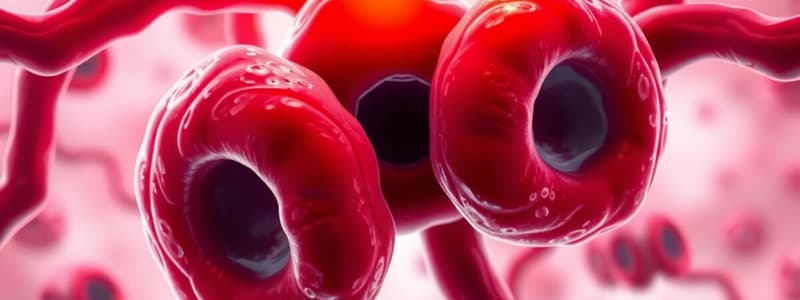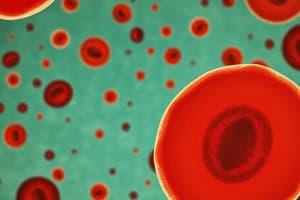Podcast
Questions and Answers
Which condition is associated with the presence of burr cells?
Which condition is associated with the presence of burr cells?
- Uremia (correct)
- Hereditary elliptocytosis
- Thalassemia
- Hydroxyurea treatment
What is the shape of red blood cells described as ovalocytes?
What is the shape of red blood cells described as ovalocytes?
- Fragmented
- Teardrop-shaped
- Oval-shaped (correct)
- Cigar-shaped
Which disorder is primarily characterized by the presence of dacryocytes?
Which disorder is primarily characterized by the presence of dacryocytes?
- Primary Myelofibrosis (correct)
- Acidemia
- Thalassemia
- Hereditary ovalocytosis
What type of red blood cell morphology is primarily observed in severe burns?
What type of red blood cell morphology is primarily observed in severe burns?
Which of the following cells is described as having a spiculated surface?
Which of the following cells is described as having a spiculated surface?
Which condition is NOT associated with pyruvate kinase deficiency?
Which condition is NOT associated with pyruvate kinase deficiency?
What is the primary shape description of schistocytes?
What is the primary shape description of schistocytes?
Which condition results in the presence of elliptocytes?
Which condition results in the presence of elliptocytes?
Flashcards
Burr Cell
Burr Cell
Red blood cell with a regularly spiculated surface.
Ovalocyte
Ovalocyte
Oval-shaped red blood cell.
Elliptocyte
Elliptocyte
Elliptical (cigar-shaped) red blood cell.
Dacryocyte
Dacryocyte
Signup and view all the flashcards
Schistocyte
Schistocyte
Signup and view all the flashcards
Uremia
Uremia
Signup and view all the flashcards
Myelofibrosis
Myelofibrosis
Signup and view all the flashcards
Microangiopathic hemolytic anemias
Microangiopathic hemolytic anemias
Signup and view all the flashcards
Study Notes
Red Blood Cell (RBC) Morphology
-
Burr Cell (A.K.A. Crenated Cell / Echinocyte):
- RBCs with regularly spiculated surfaces
- May exhibit even projections or a rounded appearance
-
Ovalocyte:
- Oval-shaped RBCs
- Associated with hereditary ovalocytosis (aka South East Asian ovalocytosis)
- Also linked to pyruvate kinase deficiency
-
Elliptocyte:
- Elliptical (cigar-shaped) RBCs
- Linked to hereditary elliptocytosis
- Can be associated with thalassemia and/or mediterrannean anemia.
-
Dacryocyte (A.K.A. Tear Drop Cell):
- Pear-shaped or teardrop-shaped RBCs
- Frequently found in primary myelofibrosis (PMF)
- PMF is a type of myeloproliferative neoplasm. Characteristics include: splenomegaly, marrow hypercellularity with increased megakaryocytes and fibrosis, immature granulocytes, normoblasts, dacryocytes, and other bizarre RBC shapes in the peripheral blood smear (PBS).
-
Schistocyte (A.K.A. Schistocyte):
- Fragmented RBCs
- Associated with conditions like patients with artificial heart valves, uremia, severe burns, certain microangiopathic hemolytic anemias (e.g., TTP, HELLP syndrome, HUS) and disseminated intravascular coagulation (DIC)
Other Conditions
-
Uremia:
- Characterized by elevated plasma urea and other nitrogenous waste products
- Often results in acidemia, electrolyte imbalance (potassium elevation), normocytic and normochromic anemia, uremic frost, generalized edema, foul breath, and urine-like sweat.
-
Primary Myelofibrosis (PMF):
- A myeloproliferative neoplasm (MPN)
- Splenomegaly, hypercellularity, increased megakaryocytes and fibrosis in the bone marrow; and immature granulocytes, normoblasts, and dacryocytes, and other bizarre RBC shapes in the peripheral blood smear (PBS).
- PMF was previously known as myelofibrosis with myeloid metaplasia, chronic idiopathic myelofibrosis, and agnogenic myelofibrosis.
-
Megaloblastic Anemia:
- Associated with myelophthisic anemia, Heinz body formation, drug /toxin ingestion, and some hemolytic conditions.
-
HUS (Hemolytic Uremic Syndrome):
- Characterized by renal failure, thrombocytopenia, presence of schistocytes in the peripheral blood smear (PBS), and severe mucocutaneous hemorrhage.
- Often associated with Escherichia coli serotype O157: H7 infection.
Studying That Suits You
Use AI to generate personalized quizzes and flashcards to suit your learning preferences.


![Hematology 2 01 [LAB] - RBC Morphology Variations Finals A.Y. 2022-2023 Topic Outline](https://images.unsplash.com/photo-1542884841-9f546e727bca?crop=entropy&cs=srgb&fm=jpg&ixid=M3w0MjA4MDF8MHwxfHNlYXJjaHw0fHxoZW1hdG9sb2d5JTJDJTIwUkJDJTIwbW9ycGhvbG9neSUyMHZhcmlhdGlvbnMlMkMlMjBmaW5hbHMlMkMlMjBtZWRpY2FsJTIwbGFib3JhdG9yeXxlbnwxfDB8fHwxNzEyMDc3MjEzfDA&ixlib=rb-4.0.3&q=85&w=300&fit=crop&h=200&q=75&fm=webp)

